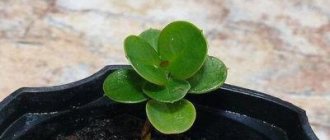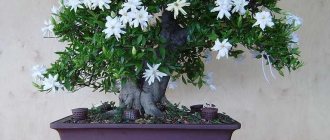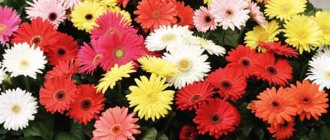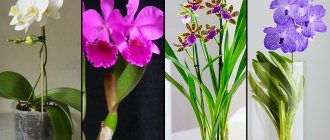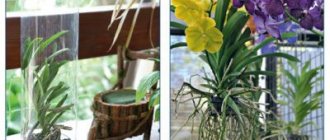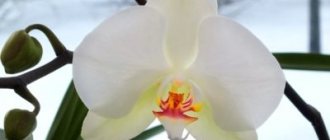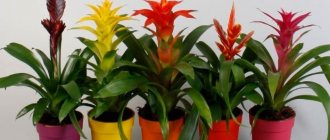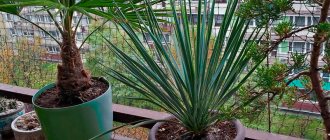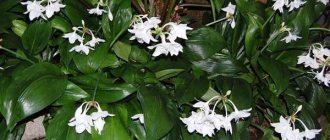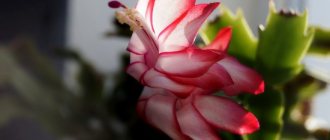Gardenia, as noted earlier, belongs to the madder family. It includes about 250 species (read more about the types of gardenias and popular plant varieties in our material). The flower grows in the subtropical forests of China and Japan. These are small trees and evergreen shrubs. The strong shoots are pubescent, the leaves are opposite and glossy.
The flowers are collected in corymbs, sometimes growing one at a time. At home, the most commonly found plant is gardenia jasmine. This plant tolerates pruning well. But despite the fact that you can easily form a crown, the flower is very demanding to care for.
How does a plant reproduce?
Gardenias are propagated in three ways:
- cuttings;
- dividing the bush;
- seeds.
Only the first method is suitable for home growing. Cuttings should be pruned in autumn or spring. Choose only semi-lignified specimens. Gardenias have an extremely low rooting percentage, so for one-time propagation you will need at least 3-5 cuttings.
Favorable environment
Reproduction of gardenia and further cultivation of young seedlings should take place in a room where there are no sudden changes in temperature. The soil for growing must be sufficiently acidic. Place containers from the plant in a well-lit place, but not in direct sun.
During the formation of buds, you cannot move a pot of gardenia from place to place.
Timing
Since the plant is most often propagated using cuttings, the best time to carry out the cutting procedure is considered to be the beginning of spring or, in extreme cases, the period after the plant has completely flowered.
What kind of flower is this?
Gardenia, as noted earlier, belongs to the madder family. It includes about 250 species (read more about the types of gardenias and popular plant varieties in our material). The flower grows in the subtropical forests of China and Japan. These are small trees and evergreen shrubs. The strong shoots are pubescent, the leaves are opposite and glossy.
The flowers are collected in corymbs, sometimes growing one at a time. At home, the most commonly found plant is gardenia jasmine . This plant tolerates pruning well. But despite the fact that you can easily form a crown, the flower is very demanding to care for.
Reproduction
Gardenia jasmine can be propagated at home in several ways. Breeders and professional flower growers will choose planting seeds - a reliable way to grow a plant without losing its species and with minimal risk of changing its decorative properties. But this path is more difficult and beginners are recommended to choose vegetative planting of seedlings.
Gardenia jasminoides propagating by cuttings involves their rooting. Semi-lignified cuttings are selected after the flowering period, as well as at the time of pruning or replanting the plant. It is optimal to select cuttings about 9-10 centimeters long.
For the steam to sprout, you need to:
- soak the cuttings in a weak solution of potassium permanganate for a couple of hours before rooting;
- root in a sand-peat substrate, proportion one to one;
- create a greenhouse with a temperature regime of +25 °C - place a cutting rooted in the soil under a glass cap or plastic film;
- expect roots to appear;
- When leaves and roots appear, they make it possible to evaluate when it is possible to transplant the “new resident” of the house into a separate pot;
- after a short period of adaptation in the pot, the cuttings are lightly pinched at the top for lush growth and better development.
The greenhouse must be ventilated and create an optimally soft air flow, avoiding drafts, and the substrate must be kept moist.
Gardenia jasminoides are not often grown from seeds, but if you wish, you should adhere to strict rules for caring for the capricious plant. To do this you need to do:
- seedlings are planted in a substrate in the spring, covered with a 3-5 mm layer of earth;
- lightly press for better grip and moisten the soil;
- the soil with seedlings is covered with a glass cap or film to create greenhouse conditions;
- It is better to place the seedlings on a southern windowsill;
- It is expected that within 30 calendar days the seedlings will slowly begin to sprout.
Propagating gardenia vegetatively is faster and more profitable.
Propagation by cuttings
This plant is considered difficult to root. It is more correct to take cuttings during the winter pruning period (late winter - early spring until April). Repeated cuttings are allowed in the summer - before flowering, but no later than in June-July. For cuttings, apical half-lignified cuttings from last year's shoots 8-12 cm long with leaves are suitable.
A suitable substrate for rooting is the same as for rose cuttings. It should be loose, light, airy, permeable to moisture and air. A mixture of sand, turf, and vermiculite is suitable. Coconut fiber and perlite should be used due to the presence of calcium in them. There is an option for rooting cuttings in peat tablets. There are also cases of rooting in water.
Process of planting cuttings:
- The bottom cut should be even and smooth.
- The cutting must be inserted 1-1.5 centimeters into the soil, but the lower leaves should not touch its surface.
- Overly large leaves on cuttings are shortened by a third in order to prevent them from evaporating a lot of moisture. The leaves are not cut off near the uppermost axil; the growth point arises there.
- You need to leave at least a couple of leaves on the cutting so that they nourish the plant until roots appear.
Main types
In nature, there are up to 250 species of this wonderful plant. However, more popular ornamental crops are used for growing in apartments and gardens.
Jasmine gardenia
This species is most often chosen for growing in apartments, as it adapts perfectly to these conditions. Jasmine gardenia has the appearance of a dense, spreading shrub up to 80 cm high. Glossy dark green leaves with a pointed edge are up to 8 cm long. Flowers that look like roses proudly stand out against their background with their snow-white color. Over time, the petals take on a yellowish tint, so you can immediately find white, cream and yellowish buds on the bush. The most common varieties are:
- “First Love” with fragrant creamy-white flowers, up to 13 cm in diameter; - “Variegata” - distinguished by its green leaves covered with a whitish-marble pattern and white double flowers; - “Fortune” - its open buds have a diameter of 10 cm.
This species has a second, completely justified name “Regal” due to its decorative effect. It has many other varieties bred through selective breeding, each of which differs in shape, size, color of foliage and buds, as well as flowering duration.
Vietnamese gardenia
This type of gardenia can be a compact tree or a lush spreading bush. The thick cover of leaves has a beautiful shiny surface, and large snow-white flowers with a diameter of up to 8 cm have rather unusual petals that curl into fancy long tubes.
Yellow gardenia
The neat tree has erect stems with glossy green leaves. Initially white buds bloom in the axils of the foliage, which then turn yellow. Over time, the color shift increases from lemon to bright orange.
Gardenia citriodora
A luxurious bush of this type of gardenia has highly branched shoots with oval glossy leaves. Its flowering is fascinating with a mass of small, no more than 2 cm in diameter, white double flowers. The plant also boasts a delicious, intense aroma.
Further care
In order to see the first flowers a year after rooting, you need to follow the basic rules of care:
- strict temperature regime;
- feeding;
- correct watering.
So, let's look at the main points of caring for gardenia.
Lighting
The flower prefers a lot of light, however, direct exposure to sunlight is contraindicated for it, since it has a bad effect on the foliage, which will begin to turn yellow and become covered with brown spots. In summer, it is best to place a gardenia pot in a shaded place.
Gardenia flowers reach up to 8 centimeters in diameter.
In winter, sunlight will no longer be so destructive, and the plant can be moved.
Temperature
In summer, the optimal temperature is 22 °C, in winter from +16 to 22 °C. The temperature regime of the soil and air should not have strong differences so that the roots do not become overcooled. A pot placed on a windowsill should not be moved or rotated in cold weather; this is dangerous for the life of the flower. In the warm season, the bushes can be taken outside, but protected from the burning sun. Important! A tropical plant reacts very sharply to sudden changes in temperature and drafts; it is also undesirable to place pots near air conditioners.
Humidity
The tropics are characterized not only by high air temperatures, but also by high humidity, which must be taken into account when caring for gardenia at home.
You can create additional humidity around the gardenia in different ways:
- place a jar of water near the pot for evaporation;
- grow gardenia near an aquarium with fish;
- purchase a special humidifier;
- spray the plant with a fine spray bottle (this can only be done before buds and flowers have formed on the plant; after that the procedure must be suspended);
- wipe the leaves with a damp cloth or rag (by removing dust, you help the plant breathe)
Watering
In winter, Augusta does not need to be particularly flooded. 2-3 waterings per month will be enough. Starting in mid-March, when buds are actively developing, change your approach to soil moisture. As soon as the top layer begins to dry out, immediately add life-giving moisture.
Pre-settle the water and warm it up a little. You can add a little citric acid or peat to a container of water. If you delay watering, you will notice that the leaves will begin to turn yellow.
Feeding and fertilizers
The need for feeding is determined by the stage of the plant's life cycle, as well as the time of year.
During active growth, gardenia should be fed at least twice a month. Liquid fertilizers designed for indoor flowers, which are sold at any flower shop, are perfect for this. It is important that the dose required for gardenia is half that indicated in the instructions.
In summer, you can fertilize gardenia by alternating mineral and organic fertilizers.
In the autumn and winter seasons, when gardenia is dormant, the plant should not be disturbed - no feeding is required.
Trimming
To ensure that hydrangea produces as many side shoots and flower buds as possible, you need to pinch off the young tops. This must be done all the time while the ward is developing, that is, in spring and summer. At the same time, get rid of diseased and weak leaves and dried flowers. If you leave the seeds to ripen, it will take a lot of energy from the flower.
After flowering, do a “general” cleaning, getting rid of excess shoots and forming a beautiful crown. But even shorten all remaining stems by a third of their height. This procedure will allow Cape jasmine to bloom magnificently next year. You don’t have to throw away healthy cuttings, but use them to produce new flowers.
Pinching and pruning gardenia
- They begin to pinch gardenias from the second year of life.
- To do this, cut off the tops of the shoots above the third pair of leaves with scissors in order to increase the branching and splendor of the crown.
- Pruning is necessary when removing dry, unsightly branches and when forming the correct shape of the crown.
- Thickening branches that grow unevenly are cut off, and branches that are too long are shortened.
- Faded flowers and dried buds are also cut off.
Gardenia tolerates pruning well, quickly pushing out new shoots instead of old ones.
How to form a gardenia bush, look at the video:
It is important not to be afraid to prune in a timely manner so that the bush develops evenly and remains well-groomed. The compact shape of the bush is maintained by constantly pinching the tops of the remaining shoots and pruning the branches at least once a year.
Gardenia bonsai
Gardenia bonsai photo
- The plant can be shaped into a bonsai style.
- To do this, form a central shoot, constantly pinching all the tops and cutting out excess branches.
- The trunk of the plant will become thicker every year, and the branches will be rejuvenated by radical pruning.
- It is important to prune before the end of autumn so that flower buds have time to form. Then the gardenia will annually delight you with its incomparable flowering on a bonsai-style mini tree.
Transfer
Once every few years the plant needs to be transplanted into a larger container.
Sometimes, gardenia owners often experience yellowing of leaves and their falling off. If you recently replanted a plant, then most likely you accidentally damaged the root system. To correct the situation, you need to create greenhouse conditions for the gardenia and remove it from direct sunlight.
Priming
You can buy soil with the required composition in a store or make it yourself. The main thing is not to use soil containing lime, which is harmful to the flower. The main condition is increased soil acidity. To prepare the soil yourself, prepare peat moss or other material that acidifies the compost.
What pots are suitable?
The new container should be several centimeters larger than the previous one and have wide holes at the bottom for drainage. The flower can be planted in either a ceramic or plastic pot. However, the latter is more preferable, since during watering it will have to be placed in a basin of water. The plastic container will not be damaged by moisture, but stains will remain on the ceramic pot.
Preparing for transplant
adjust the flower so that its root neck is underground
Cover the root mass with soil and tamp down gently to remove any air pockets. After transplanting, immediately water the plant and wait until excess moisture drains into the pan.
Reference. Place the flower where it will receive bright, indirect light. Do not allow foliage to touch the window glass. This can lead to hypothermia of the plant and various diseases.
Replanting after purchase
There is no need to rush to replant the plant immediately after purchase, since the delicate buds may fall off. Wait three to four weeks, and then place the gardenia in another pot with suitable soil.
- Place small pebbles or expanded clay at the bottom of the container, and then fill it with nutritious soil for azaleas or gardenias.
- Remove the plant from the store pot along with a lump of soil and place it in a new container.
After a month and a half, you can feed the gardenia with fertilizers for the first time.
All the secrets of transplanting this beautiful plant are in this video:
Benefit
The plant is used not only as a decorative ornament, it is used in folk medicine. Flowers and roots help in the treatment of:
- lungs;
- liver;
- kidney;
- intestines;
- skin diseases;
- stomatitis;
- mastitis;
- dysentery and other things.
Gardenia fruits are added to anti-inflammatory, choleretic decoctions and wound-healing ointments; they are considered effective for hepatitis, flu, nephritis, and headaches.
Methods to improve rooting efficiency
It is known that the process of root regeneration is regulated by growth substances - auxins, carbohydrates and nitrogenous substances. In many species and varieties, under the influence of growth regulators, the percentage of rooting cuttings, the number of roots, and the quality of plants increase, and the rooting time is reduced. Some difficult-to-root crops become easy to root, but sometimes, depending on the biological characteristics of a particular species or variety, there may be no response to stimulants.
Good root formation stimulators are:
- Heteroauxin (indoleacetic acid (IAA)) – from 50 to 200 mg/l,
- Kornevin (indolylbutyric acid (IBA)) – 1 g/l of water,
- Zircon (mixture of hydroxycinnamic acids) – 1 ml/l of water.
Treatment with stimulants should be done in the dark, at a temperature of +18...+22 degrees. The cuttings are immersed in the solution so that the leaves are not processed. The concentration of the solution and the exposure time must be maintained precisely; exceeding them may lead not to an increase in the effect, but to a toxic effect. Therefore, it is better to use Kornevin in solution and maintain strict exposure for 16-20 hours, rather than dust cuttings with it.
Humidity
A very significant aspect for the normal development of gardenia. The air around should always be moist. Every day and all the time. Even in winter. Some sources recommend spraying the crown of the bush several times a day. But this is a constant attachment. But flower growers also work, study, and visit. You can list endlessly why you can’t sit next to a gardenia.
What to do? Create the required level of humidity artificially:
- Place the pot on a tray (a stand is required). Spread sphagnum, peat, expanded clay, hydrogel around. Periodically add water so that all materials literally float.
- Place a few extra saucers or glasses around. Make sure there is always water in them.
- If you have a room humidifier, keep it constantly on near the plant.
- In the cold season, place a wet towel or blanket on the heating radiators and moisten them as they dry.
- Well, don’t forget to spray the crown with a regular spray bottle as often as possible. Preferably warm and soft (settled) water.
All these points must be completed simultaneously. Separate use will bring negligible results. And although gardenia is quite capable of growing without a high level of humidity, it will never bloom in dry air.
Advice. Some gardeners set up a mini-greenhouse on the windowsill in which gardenia lives. This makes it much easier to maintain the microclimate at the proper level. By the way, this design helps to avoid sudden temperature changes, which the plant does not like.
